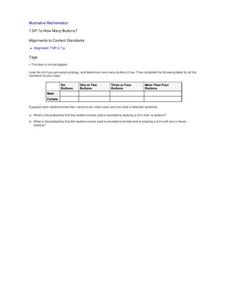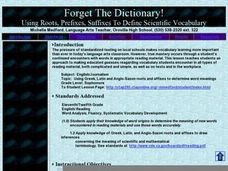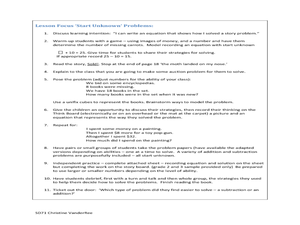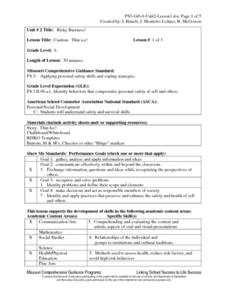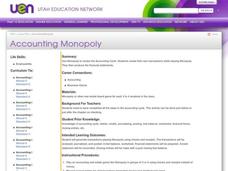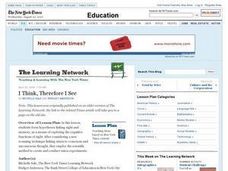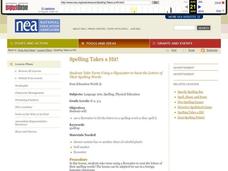Curated OER
How Many Buttons
Help learners explore the concepts of more than, less than, and equal to. They participate in a button attribute activity, play a game using buttons and a die, draw the sets of buttons in their journal, and play button bingo.
Curated OER
Forget The Dictionary!
Accessing Web sites and playing interactive word games enliven the study of Greek, Latin and Anglo-Saxon roots and affixes. Alas, the link to resources appears broken. Take some time to find game links.
NY Learns
Culture Clash: Exploring Characters within El Bronx Remembered by ECSDM
Using a character map, learners assign traits to characters from Nicholasa Mohr’s El Bronx Remembered: A Novella and Stories. In addition, groups record evidence from the stories to justify the labels and use these sheets to prepare for...
Curated OER
Solve Story Problems: Sold! A Mathematics Adventure
Young mathematicians listen to the book Sold!: A Mathematics Adventure by Nathan Zimelman where they encounter ways to solve story problems. They then create and solve start unknown addition and subtraction equations. Resource builds in...
Curated OER
Ordering Rational Numbers and Finding Their Approximate
Middle schoolers explore the concept of ordering rational numbers on a number line. They represent rational numbers as decimals and percents. Pupils create a foldable about converting fractions to decimals to percents, and use a...
Curated OER
Advanced Scribble Pictures
Scribble art allows learners of any age to problem solve in order to express their creative thinking skills. They create a simple scribble, then elaborate on it by adding color and shape. Full instructions and extensions are included.
Curated OER
Similar and Different
Fourth graders observe a pair of students standing in front of the class and compare and contrast them using a Venn Diagram using these guidelines: eye color, hair color, older/younger, tallest/shortest, gender, favorite food, favorite...
Desert Discoveries
Bird and Feather Features
Ornithology is the study of birds, and young scientists do just that with an interesting science lesson. They identify the parts of a bird, realize that birds have different types of beaks, wings, and feet, and take a close look at bird...
Curated OER
Caution: Thin ice!
Sixth graders listen to story and respond with comments or questions. They brainstorm unsafe behaviors and randomly fill out templates with different risky behaviors listed on the board. They play RISKO, the Bingo type game.
Curated OER
College Survival Vocabulary Bingo
COA? EFC? FAFSA? These terms and more are part of a list of terminology essential for college survival used in a Bingo game. The Bingo template is provided, as is an extensive of terms and their definitions.
Curated OER
Let's Play Scrabble!
What do Alfred Mosher Butts, James Brunot, and Jack Straus have in common? They were all instrumental in the development of Scrabble. Class members will discover these facts and many more as they conduct a WebQuest to gather, organize,...
Curated OER
Accounting Monopoly
Students use Monopoly to review the accounting cycle. They create their own transactions while playing Monopoly. Students produce the financial statements that will match the transactions of the game.
Curated OER
I Think, Therefore I See
Students participate in a memory experiment to discover how the eye works. After reading an article, they analyze a new technique which examines how the brain registers sight. They develop their own memory game and conduct trials using...
Curated OER
Risky Business
Students consider what risky choices may do to their lives. In this personal health lesson, students watch a Discovery video about personal choices and discuss the content of the video. Students then play a game that that allows them to...
Curated OER
How Do You Make A Tornado?
Students create a tornado in a bottle. In this climate and weather lesson, students review basic information about tornadoes and thunderstorms. Students make a tornado in a bottle and write about what they learned from the project....
Curated OER
First Aid Review
Students create and play a game to demonstrate their understanding of the skills, cues, and strategies used in first aid.
Curated OER
Spelling Takes a Hit!
Learners practice spelling and word recognition. In this spelling lesson plan, students play a game. . Learners are given a word to spell and as they call out each letter, they swat the letter with a fly swatter allowing each student to...
Curated OER
Understanding Characters
Students analyzing characters from a story by creating an article about one. In this story analysis lesson, students read Charlie and the Chocolate Factory by Roald Dahl, and pick one character to write descriptively about....
Curated OER
Wonders of Weather
Students investigate weather disasters by creating a virtual tornado. For this wild weather lesson, students define a vortex and describe how a vortex keeps a tornado moving and causing damage. Students utilize salt,...
Curated OER
Checkerboard
Students create checkerboards using paints, glue, rulers, and masking tape in this upper-elementary/middle level Art lesson. The lesson emphasizes the history of checkerboards, strategies and rules, and the checkerboard as an example of...
Curated OER
Animal Top Trumps
Second graders evaluate different animals. In this animal parts lesson plan, 2nd graders create a game that compares animals based on five concepts- attack, defend, agility, speed and size.
Curated OER
Pest Populations: A Game of Survival
Pupils identify and classify populations of pests in the home, school and community. They recognize the specific conditions needed for the survival of an organism considered a pest and list tactics for control measures.
Curated OER
Mrs. Perkins Dolch Words: #10 Create a Story
Students write their stories. In this sight words and writing lesson, students examine a list of 20 teacher-provided dolch words and use them to write their own stories. Students share their stories with their classmates.
Curated OER
Four Corner Fun: A Review Game
Twelfth graders practice academic skills by answering multiple choice questions. They role-play as fibbers or players and respond to questions accordingly, going to the A,B,C, or D corners of the classsroom. Fibbers can go to any corner.
